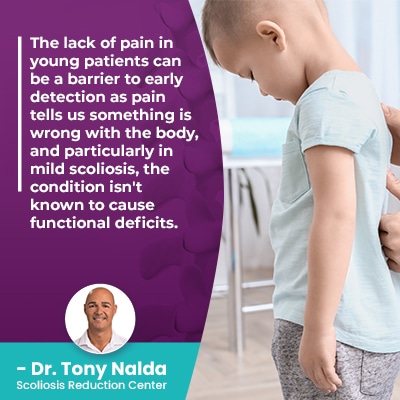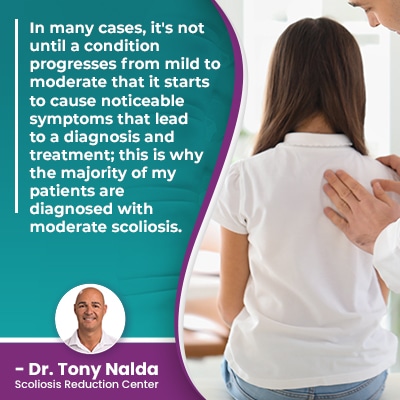What Does Scoliosis Affect? Physical Effects of Scoliosis

As the brain and spine work together to form the central nervous system (CNS), spinal conditions can cause a wide range of effects felt throughout the body. In order to minimize the condition's effects, early detection and early intervention can increase the likelihood of treatment success.
While scoliosis is a highly-variable condition, it is associated with some common effects. When it comes to scoliosis symptoms, factors such as patient age, condition type, curvature location, and condition severity all shape how the condition affects the body.
As the effects of scoliosis are shaped by factors that vary from person to person, let's start with how the condition is diagnosed and further classified based on those same factors.
Table of Contents
Diagnosing and Classifying Scoliosis
The spine's natural curves make it stronger, more flexible, and better able to handle mechanical stress, and in addition, as part of the central nervous system, spinal conditions can cause a wide range of effects felt throughout the entire body.
In order to reach a diagnosis of scoliosis, certain parameters have to be met: an unnatural sideways spinal curve of 10+ degrees has developed, and the spine rotates, making it a 3-dimensional condition.
At the time of diagnosis, conditions are comprehensively assessed so they can be further classified, and this is important for streamlining the treatment process, as well as informing the crafting of effective and customized treatment plans.
It's the condition's classification-points that factor into how it's going to affect patients, so let's go over each one: patient age, condition type, curvature location, and severity.
Patient Age
When it comes to how scoliosis affects the body, patient age is a significant factor, especially when it comes to pain and progression.
Although scoliosis involves the development of an unnatural spinal curve, which can sound quite painful, this isn't always the case, and patient age is a significant determining factor.
Scoliosis doesn't become a compressive condition until skeletal maturity has been reached, and as it's compression of the spine and its surrounding muscles and nerves that causes the majority of condition-related pain, scoliosis is far more commonly painful for adults, than children and adolescents.
Scoliosis affects all ages but is the most prevalent in children and adolescents.
 The lack of pain in young patients can be a barrier to early detection as pain tells us something is wrong with the body, and particularly in mild scoliosis, the condition isn't known to cause functional deficits.
The lack of pain in young patients can be a barrier to early detection as pain tells us something is wrong with the body, and particularly in mild scoliosis, the condition isn't known to cause functional deficits.
Now, as a progressive condition, scoliosis has it in its nature to worsen over time, and while we don't know what triggers the condition's onset in all types, we do understand what triggers its progression: growth.
So while being monitored closely for progression is a focus of treatment in young patients, this is not such a concern in the treatment of adult scoliosis because the progressive trigger of growth isn't there.
So patient age plays a crucial role in determining whether or not a condition is likely to be painful and/or a patient's progressive rate.
Now, let's move on to condition type.
Condition Type
Not only can scoliosis affect all ages, there are also multiple condition types, with unique symptoms, causation, and effects.
Condition type is determined by its underlying cause, which also has to guide the design of effective treatment plans.
There are four main types of scoliosis.
Idiopathic Scoliosis
The most common condition type to affect children and adults is idiopathic scoliosis, meaning not clearly associated with a single-known cause, and this type accounts for approximately 80 percent of known diagnosed cases.
The remaining 20 percent consist of types associated with known causes: neuromuscular scoliosis, degenerative scoliosis, and congenital scoliosis.
In the condition's most-prevalent form overall, adolescent idiopathic scoliosis, diagnosed between the ages of 10 and 18, because of the stage of puberty characterized by rapid and unpredictable growth spurts, this age group is at risk for rapid-phase progression.
So adolescents can experience a fast progressive rate, meaning the condition's effects can escalate quickly alongside the unnatural spinal curve's increase in size over time.
The main symptom of adolescent idiopathic scoliosis is postural deviation:
- The head not being centered over the torso
- Uneven shoulders
- Uneven shoulder blades
- Uneven hips
- The development of a rib arch
- Arms and legs that appear to hang at different lengths
These types of postural changes are also shaped by severity and the degree of rotation, which can vary from patient to patient; however, the aforementioned common symptoms of adolescent idiopathic scoliosis are related to the condition's uneven forces disrupting the body's overall symmetry.
Additional symptoms that can also get worse with progression are changes to gait, balance, and coordination.
Remember, other than some related muscle pain, scoliosis in children and adolescents isn't known to be commonly painful, so in this condition type, pain management is neither a focus of treatment, nor an overly-noticeable part of life with the condition.
Neuromuscular Scoliosis
Some condition types are considered atypical so have unique treatment needs, such as neuromuscular scoliosis that's caused by the presence of an underlying neuromuscular condition: muscular dystrophy, cerebral palsy, and spina bifida, to name a few.
In these types of atypical cases, they tend to be more severe and have more severe effects, such as the risk of becoming nonambulatory (wheelchair bound and unable to walk on their own).
Degenerative Scoliosis
In cases of degenerative scoliosis that mainly affect older adults 40+ years of age, natural age-related spinal degeneration comes into effect, so while the progressive trigger of growth is removed, progressive rates can increase due to the overall health of the spine.
So as you see, condition type also shapes how a condition is likely to affect a person.
Congenital Scoliosis
Congenital scoliosis is caused by a malformation within the spine itself that develops in utero, so infants are born with the condition.
This type is rare, affecting approximately 1 in 10,000, and as its underlying cause is the spine not forming properly, the condition is associated with other issues related to malformations within the body, so these patients need to be checked for other abnormalities.
Curvature Location
There are three main spinal sections, and while scoliosis most commonly develops in the thoracic spine, it can develop in any section: cervical spine (neck), thoracic spine (middle/upper back), and lumbar spine (lower back).
When it comes to the direct effects of an unnatural curvature of the spine, the area of the body located closest to the scoliotic spinal section is going to be the most affected.
For example, patients with scoliosis in the thoracic spine are more likely to develop a prominent rib arch because the scoliosis is affecting the nearby rib cage.
In cases of lumbar scoliosis, while it's not a guaranteed complication, it is quite common that as lumbar scoliosis affects the lower spine and body, sciatic nerve pain can become an issue; the sciatic nerve starts in the lower back and extends down the back of the lower body.
So as you can see, where along the spine the unnatural curvature of the spine develops does impact how the condition affects the body.
Another key factor is condition severity, and scoliosis ranges widely from mild scoliosis to very-severe scoliosis.
Condition Severity
Scoliosis severity is determined by a measurement known as Cobb angle, which is taken during X-ray and tells me how far out of alignment a scoliotic spine is.
In addition, the measurement places conditions on a severity scale:
- Mild scoliosis: Cobb angle measurement of between 10 and 25 degrees
- Moderate scoliosis: Cobb angle measurement of between 25 and 40 degrees
- Severe scoliosis: Cobb angle measurement of 40+ degrees
- Very-severe scoliosis: Cobb angle measurement of 80+ degrees
How severe the abnormal curvature of the spine is determines many of its symptoms and shapes the design of effective treatment plans.
Mild scoliosis affects the body in mild ways, often unnoticeable.
 In many cases, it's not until a condition progresses from mild to moderate that it starts to cause noticeable symptoms that lead to a diagnosis and treatment; this is why the majority of my patients are diagnosed with moderate scoliosis.
In many cases, it's not until a condition progresses from mild to moderate that it starts to cause noticeable symptoms that lead to a diagnosis and treatment; this is why the majority of my patients are diagnosed with moderate scoliosis.
Severe and very severe scoliosis affects are overt, and if left untreated, the risk of developing complications is there: digestive system issues, a disruption to the flow of cerebrospinal fluid (headaches and migraines), chronic back pain, severe nerve compression, a disruption to the overall brain body connection, acid reflux, body image and related mental health issues.
With severe scoliosis, there's going to be a degree of nerve compression, particularly in adults for whom the condition is compressive, and this can cause a tingling sensation in the affected area, issues with fine motor control, leg pain, the development of irritable bowel syndrome, sleep issues, and more.
The main take-away here is that these types of severe symptoms and complications can be avoided, in many cases, by responding to a diagnosis with proactive treatment.
Conclusion
So how scoliosis affects the body is going to vary from patient to patient; symptoms one patient experiences aren't always indicative of what others will face.
Treating scoliosis proactively can minimize the types of effects, and potential complications, associated with increasing condition severity.
Here at the Scoliosis Reduction Center, I apply a conservative chiropractic-centered treatment approach to, first and foremost, impact the spinal deformity on a structural level because its underlying nature is structural.
While there are no treatment guarantees, reducing an abnormal spinal curvature via precise chiropractic adjustments that work towards realigning the spine means decreasing the condition's uneven forces, and their effects.
Once I see structural results, using condition-specific physical therapy can help with increasing core strength so the spinal column is optimally supported by its surrounding muscles.
Corrective braces can also help with augmenting corrective results by pushing the spine into a normal position and healthier alignment.
Further stabilizing the spine through a series of custom-prescribed exercises that can be done at home helps patients establish a home-rehabilitation program for long-term sustainable treatment results.
A focus of my treatment approach is prevention; I want to minimize the condition's effects by proactively working towards preventing progression by impacting conditions on every level.
While some patients opt for a traditional treatment approach that involves surgical treatment, spinal fusion surgery has its own set of risks and effects, which can include a reduced range of motion and spinal flexibility.
If a person wants to minimize the condition's effects, the best response to a diagnosis of scoliosis is proactive treatment that works towards reducing the abnormal sideways curvature on a structural level, as that is the underlying cause of related symptoms.
Dr. Tony Nalda
DOCTOR OF CHIROPRACTIC
After receiving an undergraduate degree in psychology and his Doctorate of Chiropractic from Life University, Dr. Nalda settled in Celebration, Florida and proceeded to build one of Central Florida’s most successful chiropractic clinics.
His experience with patients suffering from scoliosis, and the confusion and frustration they faced, led him to seek a specialty in scoliosis care. In 2006 he completed his Intensive Care Certification from CLEAR Institute, a leading scoliosis educational and certification center.
About Dr. Tony Nalda
 Ready to explore scoliosis treatment? Contact Us Now
Ready to explore scoliosis treatment? Contact Us Now





